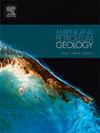得克萨斯州米德兰盆地宾夕法尼亚系克莱因页岩的高分辨率化学成分和孔隙系统特征描述
IF 3.7
2区 地球科学
Q1 GEOSCIENCES, MULTIDISCIPLINARY
引用次数: 0
摘要
人们对深水泥岩的沉积环境、沉积化学和孔隙结构之间的联系还不完全了解。本研究1)研究了米德兰盆地中心的宾夕法尼亚克莱恩页岩化合层的沉积物化学性质和沉积条件;2)描述了各泥岩化合层有机质积累的有利条件;3)研究了孔隙结构与泥岩的古环境、古地球化学背景和过程之间的联系。本研究采用 X 射线荧光 (XRF) 和统计方法(隔离林、主成分分析和 K-均值),对位于得克萨斯州格拉斯科克县米德兰盆地沉积中心的 Matthew 'D' 0906 井的 127 米克莱恩页岩岩心进行了四种化合层的鉴定。此外,还对薄片、岩心板块和样品进行了岩相学和扫描电子显微镜检查,并通过双能计算机断层扫描、X 射线衍射、Rock-Eval 热解、N2 等温吸附测试和泥岩储层特性进行了测量,以了解泥岩的体质地球化学和岩石物理特性。确定了四个化合层:(1)硅质泥岩,Zr 高,Ca 和 P 低;(2)钙质-砾质泥岩 I,Ca 和 Zr 高,P 低;(3)砾质泥岩,P 高,Ca 和 Zr 低;(4)钙质-砾质泥岩 II,Ca 和 P 高,Zr 低。根据元素分布,前两个化合层和后两个化合层分别被解释为低海平面沉积和高海平面沉积。水的分层作用和 P 的再生作用使总有机碳(TOC)含量最高,从而导致低海平面硅质泥岩化合层的孔隙度和孔隙体积较高,特别是在 8 nm-186 nm 的有机质孔隙中尤为明显。碳酸盐的输入阻碍了无机孔隙系统的发育,尤其是对有机质贫乏的石灰质-砾质泥岩而言。在岩芯中观察到九个海平面周期,并与美国中大陆的九个周期相关联,这些周期归因于宾夕法尼亚晚期 405 千年的米兰科维奇参数(长轨道偏心率)。我们推测,以轨道周期为步调的宾夕法尼亚晚期气候变化控制了泥岩化学成分的分布和堆积模式,这也控制了源岩的质量以及随之而来的孔隙系统的发育。本文章由计算机程序翻译,如有差异,请以英文原文为准。
High-resolution chemofacies and pore system characterization of the Pennsylvanian Cline Shale, Midland Basin, Texas
The connections between the depositional environment, sediment chemistry, and pore structure of deep-water mudstones are still not completely understood. This study: 1) investigates the sediment chemistry and the depositional conditions of the Pennsylvanian Cline Shale chemofacies in the center of the Midland Basin, 2) characterizes the conditions favorable to organic matter accumulation of each mudstone chemofacies, and 3) examines the connection between the pore structure and the mudstones’ paleo-environmental and paleo-geochemical context and processes. This study uses X-ray fluorescence (XRF) and statistical methods (Isolation Forest, Principal Component Analysis, and K-means) to identify four chemofacies of 127 m of Cline Shale core from the Matthew 'D' 0906 well located in the Midland Basin depocenter in Glasscock County, Texas. In addition, petrographic and scanning electron microscopy and measurements by dual-energy computed tomography, X-ray diffraction, Rock-Eval pyrolysis, N2 isothermal adsorption tests, and mudrock reservoir properties were conducted on thin-sections, core slabs, and samples to understand the bulk geochemistry and petrophysical properties of the mudstones. Four chemofacies are identified: (1) Siliceous Mudstone with high Zr and low Ca and P, (2) Calcareous-argillaceous Mudstone I with high Ca and Zr, and low P, (3) Argillaceous Mudstone with high P and low Ca and Zr, and (4) Calcareous-argillaceous Mudstone II with high Ca and P, and low Zr. Based on elemental distribution, the first two and last two chemofacies are interpreted as low sea-level deposits and high sea-level deposits, respectively. Water stratification and P regeneration accounted for the highest total organic carbon (TOC) content, which resulted in the high porosity and pore volume of the low sea-level Siliceous Mudstone chemofacies, especially visible in the 8 nm–186 nm organic matter pores. Carbonate input hinders the development of the inorganic pore system, especially for organic lean Calcareous-argillaceous Mudstones. Nine sea-level cycles were observed in the cores and correlated to nine US mid-continent cycles attributed to the 405-kyr Milankovitch parameter (long orbital eccentricity) during the late Pennsylvanian. We hypothesize that late Pennsylvanian climate change, paced by orbital cycles, controlled the distribution and stacking pattern of mudstone chemofacies, which also controlled source rock quality and consequent pore system development.
求助全文
通过发布文献求助,成功后即可免费获取论文全文。
去求助
来源期刊

Marine and Petroleum Geology
地学-地球科学综合
CiteScore
8.80
自引率
14.30%
发文量
475
审稿时长
63 days
期刊介绍:
Marine and Petroleum Geology is the pre-eminent international forum for the exchange of multidisciplinary concepts, interpretations and techniques for all concerned with marine and petroleum geology in industry, government and academia. Rapid bimonthly publication allows early communications of papers or short communications to the geoscience community.
Marine and Petroleum Geology is essential reading for geologists, geophysicists and explorationists in industry, government and academia working in the following areas: marine geology; basin analysis and evaluation; organic geochemistry; reserve/resource estimation; seismic stratigraphy; thermal models of basic evolution; sedimentary geology; continental margins; geophysical interpretation; structural geology/tectonics; formation evaluation techniques; well logging.
 求助内容:
求助内容: 应助结果提醒方式:
应助结果提醒方式:


